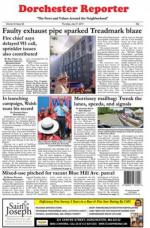April 28, 2016
Early city council hearings on the five-year budget proposed by Mayor Martin Walsh have opened with a general spending overview and an expansive look at the schools budget that have emphasized the strain on Boston’s revenue sources amid the clamor of opposition to cuts in spending on education.
As the city walks a careful line in avoiding deficits, Mayor Martin Walsh has laid out a Fiscal Year 2017 $2.97 billion budget that invests heavily in education and public safety. “We do have continuing challenges that require a high degree of vigilance to keep costs under control,” said Dave Sweeney, chief financial officer for the city, in testifying before the city council on Monday.
As the administration cautioned when releasing the budget early this month, some costs are growing at an unsustainable rate. Personnel costs, driven by rising health care and pension obligations, are among the ballooning expenditures.
“It’s only through achieving savings in this budget that we are able to make investments,” Katie Hammer, the city’s budget director, told the council, citing cuts that have been made, like lowering police overtime rates, as trade-offs to keep costs within reason.
Boston’s revenue model is limited, relying heavily on property taxes, noted Sam Tyler, president of the Boston Municipal Research Bureau. The city has steadily increased that reliance, he said. In 2002, Boston derived 52 percent of its revenue from property taxes, and 30 percent from state aid. A decade later, state aid constituted 16 percent of revenue compared to 65 percent from property taxes.
The mayor’s latest budget the pattern: The property tax is expected to constitute 68 percent of its revenue, with state aid contributing 15 percent.
Councillor Mark Ciommo, who chairs the Ways and Means committee that is overseeing budget discussions, said that seeking to expand revenue sources should be a long-term priority, a sentiment echoed by other council members.
“So, over the next few weeks as we review the budget, if there are other ways the council and the administration could work together on enhancing revenue sources and exploring that, just let us know and keep us informed,” he said to the finance officials.
A quarter of the city’s capital dollars go to roads, transportation, and infrastructure, according to the budget proposal. A slightly smaller amount goes to education, with other significant investments in public safety and parks. Tyler noted that the decline in state-provided charter school reimbursements is putting a greater strain on Boston’s resources as they are allocated toward making up the difference.
The city’s charter tuition payments have grown to 5 percent of the current budget proposal, and the charter assessment is projected to grow by 131 percent between fiscal years 2011 and 2017, CFO Sweeney said. This represents a $90 million increase in funding, while the state has underfunded reimbursements by $28 million over the past two years.
The clamorous conversation over potential cuts to the public schools has been swirling for months, including a walkout of high school students and objections from parents to lost resources for special needs students.
On Tuesday, BPS superintendent Tommy Chan told the council that the budgeting process began with asking schools to come to the department with their needs, requests, and suggestions so that investments could be prioritized. “It was that initial guidance that helped us really tee up a budgeting process with our schools that got us to a budget where we minimized the cuts that we made to schools and found greater efficiencies in central office,” he said.
The school department’s chief financial officer, Eleanor Laurans, walked the council through an overview of the $1.027 billion schools budget, which will be parsed further in future hearings.
Education spending has grown by 6 percent each year for the past 5 years, Laurans said, adding that costs for the public schools are up by $38 million this fiscal year, $8 million of which are savings in progress. As Monday’s hearing noted, state and federal aid are declining, and despite an additional $13.5 million in appropriations this year, the schools anticipate needing $31 million in cost reductions to fund all investments and maintain a balanced schools budget.
Most of the cuts ($26 million) would come out of central departments, officials said, and $5 million would land on individual schools to shoulder.
The council will continue to hold budget hearings through June, including deeper dives into departmental details. The police department hearing is scheduled for Thursday (April 28) and the next BPS hearing is May 2.
Topics:



